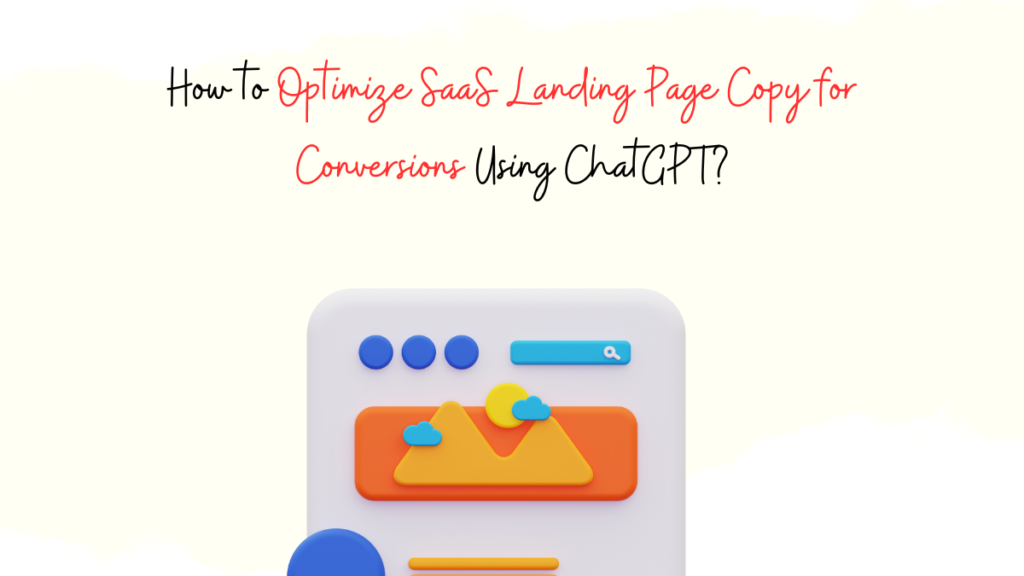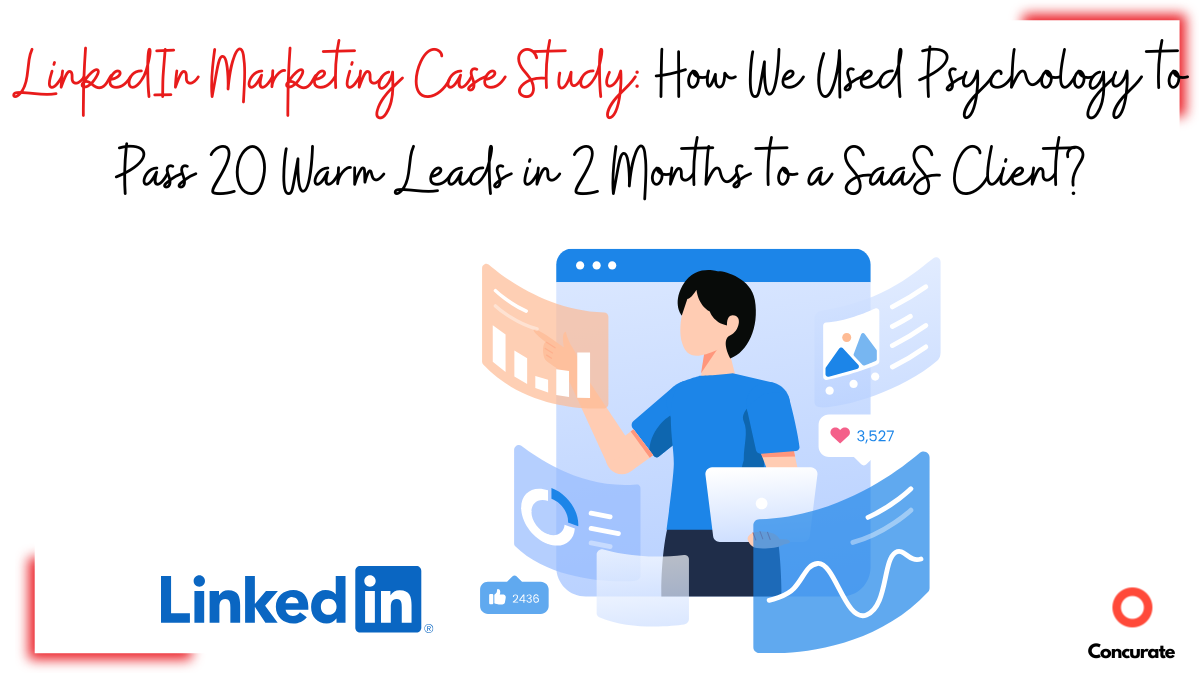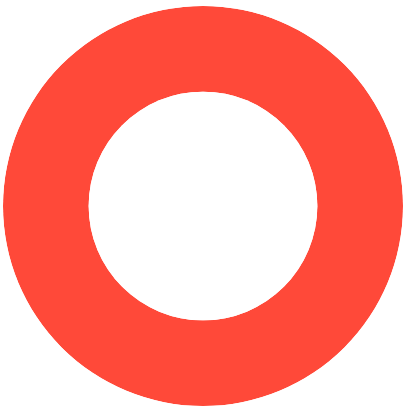Want a landing page that converts like crazy? Hiring a copywriting pro can be pricey.
I used to charge $350 when starting four years ago, but today it would be $1,000. Some highly proficient and established copywriters charge $5,000 for a single landing page.
Pretty steep, huh?
Next, being on a budget, you may try writing it yourself, but without the right skills and knowledge, your efforts might fall flat.
And hiring an inexperienced freelancer won’t cut it either.
With all the buzz around, it is obvious to feel tempted to explore ChatGPT for creating a compelling copy.
And why not leverage the powerful ChatGPT prompts showcased in this article to craft a compelling landing page copy?
I have prepared the prompts by studying the best practices and drawing from my experience creating high-performing landing pages for numerous clients.
ChatGPT Prompts + Tips for Killer Landing Page Copy
Imagine this: A visitor lands on your website, intrigued but hesitant to take the leap and become a lead or customer. That’s where a landing page shines.
A landing page is a focused web page with one goal: to prompt visitors to take action, whether signing up for a SaaS tool or a campaign, downloading a template, guide, or ebook, making a purchase, or subscribing to a newsletter, etc. The landing page engages and persuades by providing all the necessary information for a confident decision.
Consider it a first date: You aim to impress and persuade them to take the next step. The remarkable landing page boasts clear calls to action, relevant info, and an irresistible offer. These elements combine to drive conversions and transform curious visitors into loyal customers.
Irrespective of the purpose of the landing page, some sections would be common, and some would differ. So to present you with killer ChatGPT prompts, we have taken a section-by-section approach. Moreover, to demonstrate the prompts, we have picked a SaaS tool called MailChimp for easier understanding.
Also read: How to Write a Kickass Copy for SaaS Website Home Page?
Hero Section
A Headline, Sub-Headline, and Call to Action
Best Practices
- Headline: Your headline should be concise and clear, communicating the value the person would get by taking action on your landing page. It should be attention-grabbing and make the reader want to learn more. Make sure to:
- Clearly state your value proposition in a header.
- The title should say- “Who is this for” and “What should visitors get” and promise a transformation.
- Subheadline: The subheadline must provide additional context or information to support your headline. It should be succinct and highlight a secondary benefit of taking the desired action on your landing page.
- CTA: Your call-to-action (CTA) should be prominent and encourage the user to take action.
- Use action-oriented language and specify what the user will receive or accomplish by clicking the button.
- Your CTAs should be easy to spot and use.
- You may also include multiple CTAs like MesiterNote, leaving no room for visitors to miss the button.
- Use language that creates a sense of urgency and communicates the benefits of taking action.
Prompt
Write a compelling Hero Section including only Headline, Sub Headline, and CTA for MailChimp Landing Page Copy.
**PASTE THE VALUE PROPOSITION IN A SHORT PARAGRAPH**
- Clearly state the value proposition in a headline.
- The title must say- “Who is this for” and “What should visitors get”, promise transformation and show them the way.
- Make the headline strong, and clear.
- Use Powerful adjectives and emotion-provoking words.
- The subheadline should provide additional context or information to support your headline.
- The subheading should be succinct and highlight a secondary benefit of your product.
- Write two CTAs in a specific language to view plans and sign up for the free trial
- The CTA should use action-oriented language.
- Use language that creates a sense of urgency and communicates the benefits of taking action.
- Use the words the customers use, not the words the marketing department uses.
Example

Pain Points
It’s important to note that pain point resonance may not be the primary focus in scenarios where you are targeting a specific action, such as downloading a template guide or ebook or subscribing to a newsletter.
That is because the focus may be to drive the reader with value rather than pain point resonance.
Nevertheless, when striving to boost sign-ups or generate sales for a SaaS tool, it becomes vital to integrate pain points into the messaging. This approach helps establish an emotional connection with potential customers and demonstrates how the SaaS product addresses their specific challenges.
Best Practices
When writing pain point descriptions for your SaaS landing page, begin by acknowledging the challenges and emotions of your target audience.
- Use powerful adjectives to describe the pain points, such as frustrating, overwhelming, time-consuming, and exhausting.
- Use language your customers will understand, not fancy marketing jargon.
Prompt
Write compelling Pain Points sections for MailChimp Landing Page Copy.
“PASTE PAIN POINTS IN CRISP HEADINGS”
- Write pain points in a tabular view
- Write a crisp headline for each, and one sentence explanation strictly up to 15 words.
- The explanation should be the expansion of the heading, not how the product/service solves the pain point.
- Use powerful adjectives to describe the pain points, such as frustrating, overwhelming, time-consuming, and exhausting.
Example
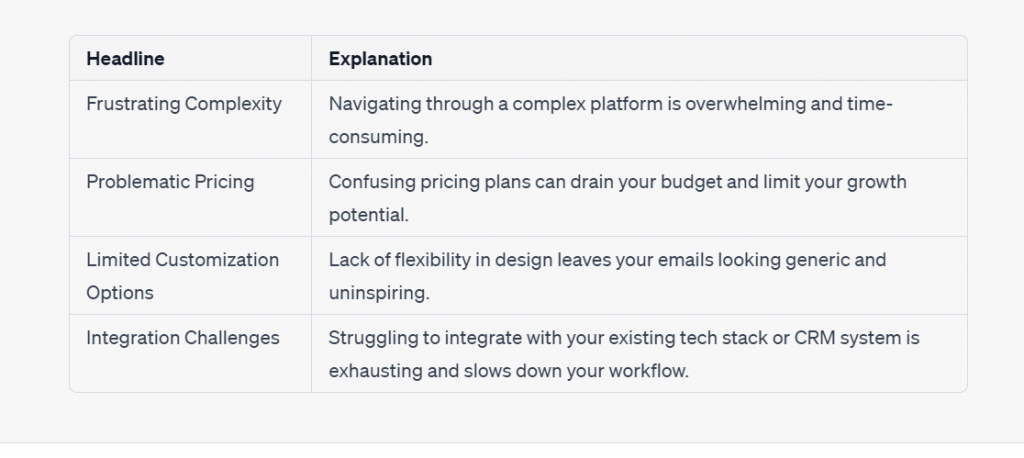
Product or Offering Description
The product description on a SaaS landing page highlights why this SaaS solution perfectly matches your needs. It provides an overview to potential customers and entices them to learn more about the product.
For a campaign landing page, this section shall be about what to expect as a campaign participant.
While the structure and length of this section may vary depending on the specific goals of the landing page, having one is essential.
Best Practices
- Use clear and concise language to convey the value proposition
- Include an overview
- Use persuasive and compelling language
- Use bullet points, short paragraphs, or subheadings format
Prompt
Write a compelling Product Description for MailChimp Landing Page Copy.
“PASTE A BRIEF ABOUT THE PRODUCTS”
- Write a catchy heading that states the value proposition and entices readers to read the description later
- Use clear and concise language to convey the value proposition
- Use persuasive and compelling language
- Write a description in a short paragraph with a word limit of 50 words as an extension of the subheading
Example
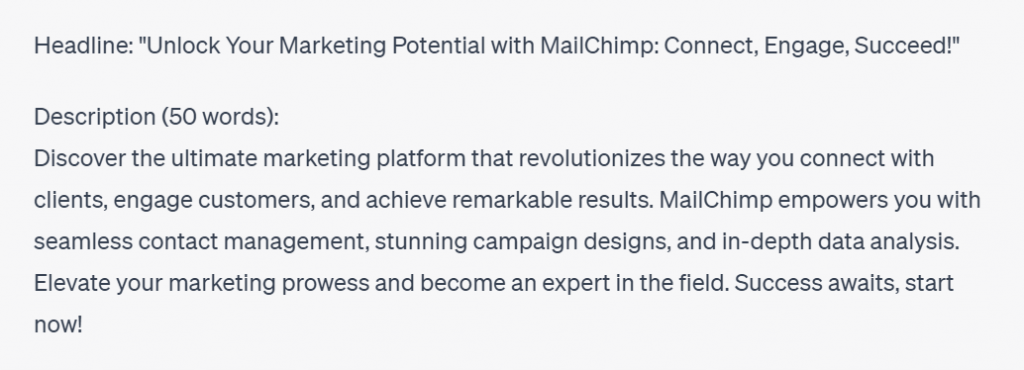
Benefits
The desire to minimize pain and maximize pleasure drives human buying decisions. Hence, the most common mistake a copywriter must avoid is to focus on features instead of benefits. As:
- Features: Features refer to specific characteristics or attributes of a product or service.
- Benefits: Benefits, on the other hand, describe the advantages, outcomes, or results the customers gain from using a product or service.
Hence, the benefits section must show how the user would benefit from your product/service or offering on the landing page.
Best Practices
- Use power words for headers
- Tell the benefit in the header
- Tell which features lead to the benefits in the subheader
- Use simple and relatable language for subheaders, i.e., the short description which follows the headers
- Avoid technical jargon or buzzwords that may confuse or intimidate them
- Use short paragraphs for better readability
Prompt
Write a compelling benefits section for MailChimp Landing Page Copy.
“PASTE PRODUCT BENEFITS WITH HEADINGS AND SUBHEADINGS”
- Make headers catchy and emotionally evocative to state benefits in 2-3 words
- User power words in headers to showcase benefits
- Write in an active voice
- Use simple and easy-to-understand language
- Avoid technical jargon or buzzwords
- Write the subheader to tell how a particular feature leads to the benefit
- Keep the subheader under 35 words.
- Present headers and subheaders in a tabular format, with one column for the header and another for the subheader
Example

Elevate your SaaS copywriting game with these additional tips.
Social Proof
The social proof section is not something you can generate with ChatGPT. However, ChatGPT can assist you in writing testimonial request emails for your highly engaged SaaS users or drafting a testimonial to minimize the friction for the client.
Here are some best practices for preparing a compelling email template to request social proof:
- Personalize the message
- Keep it concise
- Ask for specific examples of how the product or service has helped the client.
- Offer a reward to encourage clients to take action.
- Use a friendly and conversational tone
- Provide clear instructions on “how to provide” social proof, whether it’s through a testimonial, review, case study, or other format.
Prompt
Write an engaging and compelling template to request social proof from your clients for MailChimp landing page copy that converts:
- Write an email in 100 words
- Address the client by name
- Keep the message brief and to the point.
- Use short and clear sentences
- Ask for specific examples of how the product or service has helped the client
- Add an incentive of a 5% discount on their Premium Plan for providing social proof
- Write in a friendly and conversational tone
- Use relevant emojis
- Ask for social proof in a short video format via Loom for easy sharing.
- Add a CTA that motivates the reader to provide social proof
Example

FAQ Section for Overcoming Objections
Often, prospects may have objections or hesitations about your SaaS product. The FAQ section provides an opportunity to address these objections head-on and provide persuasive answers to alleviate doubts.
One way to improve your chances of converting prospects into customers is by proactively addressing any objections they may have beforehand.
Best Practices
- Address common objections, that potential customers may have, such as price, complexity, or implementation time.
- Include relevant keywords and phrases to optimize the FAQ section for SEO.
- Provide detailed and informative answers to address objections thoroughly.
- Use a conversational tone to make the FAQ section more engaging and approachable.
- Ensure consistency in tone and style with the overall branding of your SaaS product.
Prompt
Write FAQ Section for Overcoming Objections to include for MailChimp landing page.
**PASTE THE OBJECTIONS AND ANSWERS INFORMATION**
- Provide informative answers in 35 words.
- Provide answers in clear and concise language
- Use conversational tone
Example
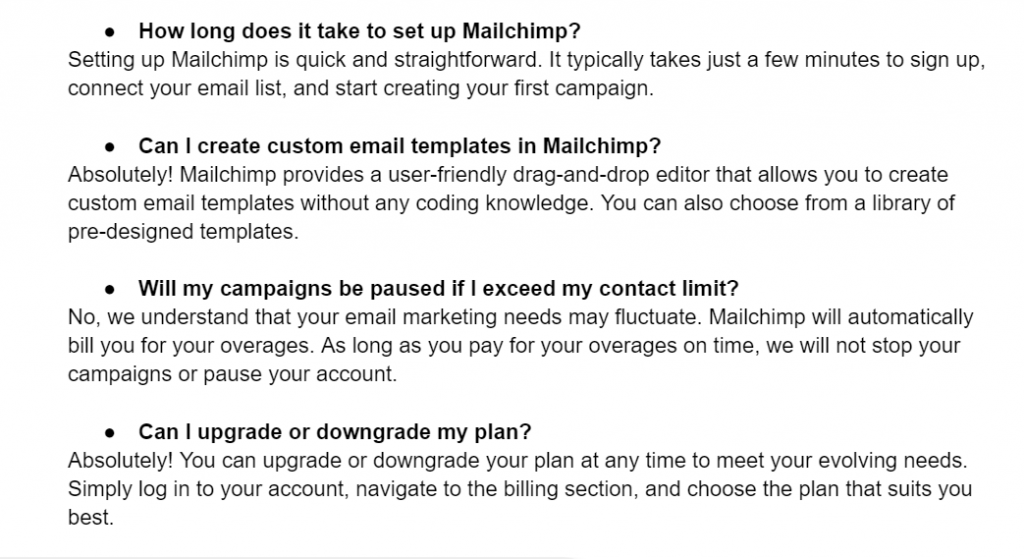
CTA Section
This CTA section comes at the end of the landing page to reinforce the value proposition and inspire the visitor to take action.
Best Practices
- State the unprecedented in the headline
- The subheadline must be action-oriented
- The CTA should be direct and concise
Prompt
Write an engaging CTA section for the MailChimp landing page.
- Write an impressive headline similar to try before you buy.
- Write a sub-headline in 8 words urging visitors to try MailChimp to get more opens, clicks, and sales.
- Write a direct CTA to start a free trial.
Example

Bonus Read
Uncover the SaaS website structure secrets to turn it into a 24×7 star salesperson.
Parting Thoughts
As you utilize ChatGPT to enhance your SaaS landing page copy, it is crucial to remember that the output directly reflects the prompts you provide. Hence, it’s best to be ultra-specific with the prompts.
For enhanced copy that captivates readers, it’s best to take the time to review every little detail of the output generated by ChatGPT. Let’s face it, adding a human touch to your ChatGPT results is still a must. Perfect AI-generated copy without any edits is hard to come by, but don’t fret! The whole point of using ChatGPT to optimize your landing page copy is to make things easier.
And with the prompts we have shared in this article, the journey becomes a breeze.
Ready for some serious value? Subscribe to our newsletter today and get updates every 15 days!


